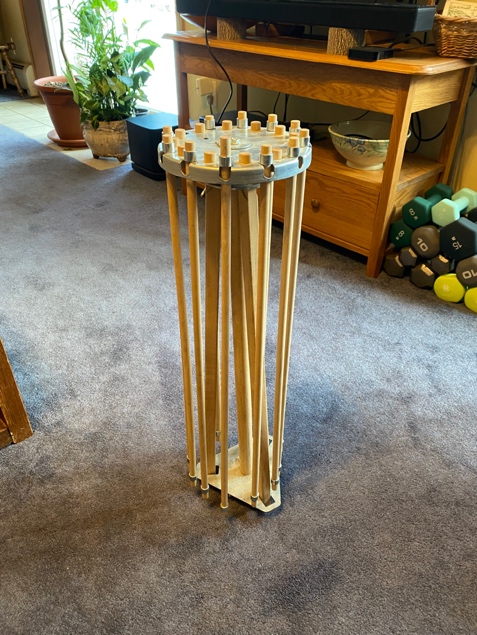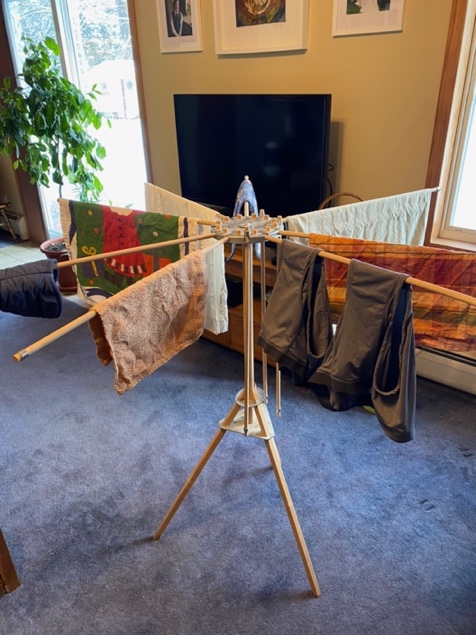Daryl Odhner from The Mother Earth Committee wrote the following:
This blog is about saving energy by air-drying clothes. According to the Natural Resources Defense Council (NRDC, 2011):
Over the last 50 years, clothes dryers have become a standard feature in nearly 85% of American homes. A typical electric dryer uses about 800 kWh per year and a typical gas dryer uses about 30 therms of gas each year. On average, Americans dry five loads of laundry a week, spending about $100 a year to power a typical electric dryer, or $40 a year to operate a similar natural gas dryer. In total, dryers now represent a $9 billion annual national energy bill – about 6% of residential electricity consumption and 2% of residential natural gas consumption. They consume as much electricity per year – 60 billion kWh – as the entire state of Massachusetts and are responsible for 40 million metric tons of annual carbon dioxide emissions. By any measure, their energy use and environmental impact are large enough to be worth doing something about.
While new clothes washers use about 70% less energy than models sold 18 years ago, clothes dryers have made almost no progress in improving energy efficiency during the same period.
In addition to the energy consumption of the dryer, the dryer exhausts heated building air out of the home, adding to the energy expenditure.
I find that air-drying clothes outdoors in the warm part of the year, and indoors in the cooler part of the year to be relatively easy once you have the right tools. Backyard warm weather drying does not have to be unattractive (or even conspicuous), and indoor drying can add needed humidity during the dryness of the winter season. It’s difficult to dry sheets indoors, so we still use our drier at times. But even drying some clothes can save energy.
We have used an outdoor “umbrella” clothesline, which arguably is probably less conspicuous and less unattractive than a horizontal clothesline. I enjoy the peacefulness of hanging clothes up on a warm day and listening to the birds. A clothespin apron and/or hanging cloth bag are helpful. I use hangers for shirts.
Clothes may even hold up longer when air-dried, since fabric tends to be lost as lint in the dryer. One thing we have noticed is that air-dried clothes are sometimes stiff. This is likely partly due to excess detergent, which should then be cut back. Also, clothes can be fluffed in the dryer on a no-heat setting.
Indoors we have two types of clothes drying racks: 1. A horizontal folding scissor rack, and a folding umbrella model. We also use a horizontal rigid pole fastened so as to support hangers. A basement clothesline would be another alternative. Please see photos. The bottom photo is of my Mom—a steadfast air-drier over her 94 years—at her Philadelphia area apartment.



4 Comments
Mary Heveron-Smith
Nice column, Daryl! My husband and I do air-dry a lot of clothes, so we’re with you on this. Another thing we try to do is to save energy with our dishwasher. Why should we expend energy for the dishwasher to dry our dishes, when it’s just as easy to open the dishwasher when the washing cycle is complete, and let everything air dry? We do this just about every time we run the dishwasher. A tiny thing, but lots of tiny things add up.
Monica Anderson
Great start to recognizing that we must choose which is a priority: preventing extreme weather events or external beauty.
Joan Chandler
We are air drying our clothes and find a significant savings on our energy bill.
Annette Mackin
Good article. Unfortunately apartment/condo living is not very conducive to the natural drying techniques described above. However, there are a number of things we can do to reduce drying time and thus decrease our energy drain. Separating laundry by fabric content and/or fabric weight can reduce the overall amount of time needed to dry a washer full of laundry. I pull out all the “heavy” stuff (like sweatshirts and jeans) and set it on top of the dryer to air dry while I run the lighter stuff through a medium dryer cycle. If the sock toes are still damp they spend the day (or night) on top of the dryer. Using a folding rack dryer to partially dry laundry before tossing it in the dryer for final dry and fluff is also an energy saver. Having your dryer vent pipe cleaned completely from top to bottom or beginning to end can result in a major improvement in drying efficiency especially if it isn’t cleaned on a regular basis.
Commenting has been turned off.